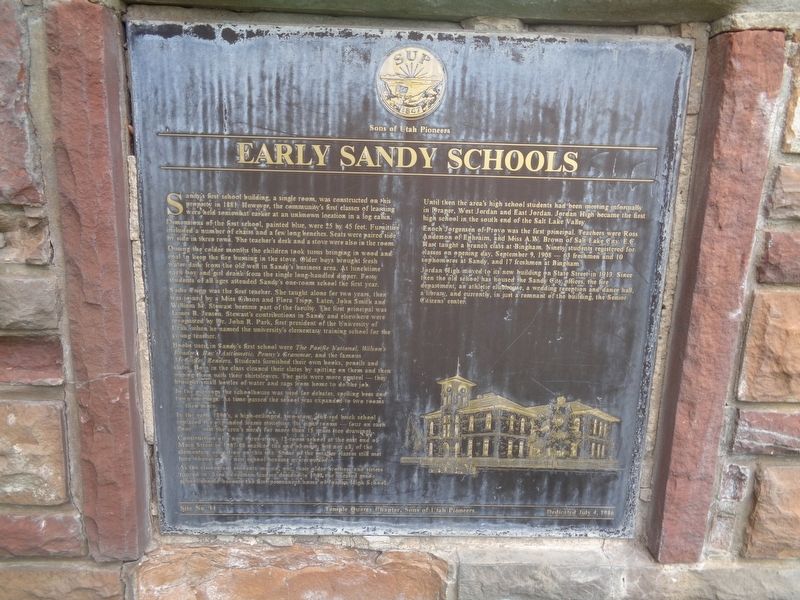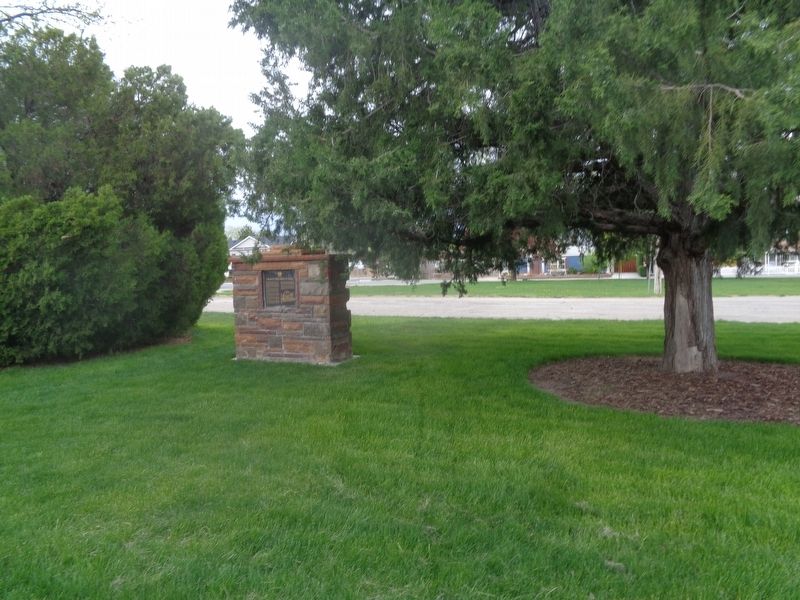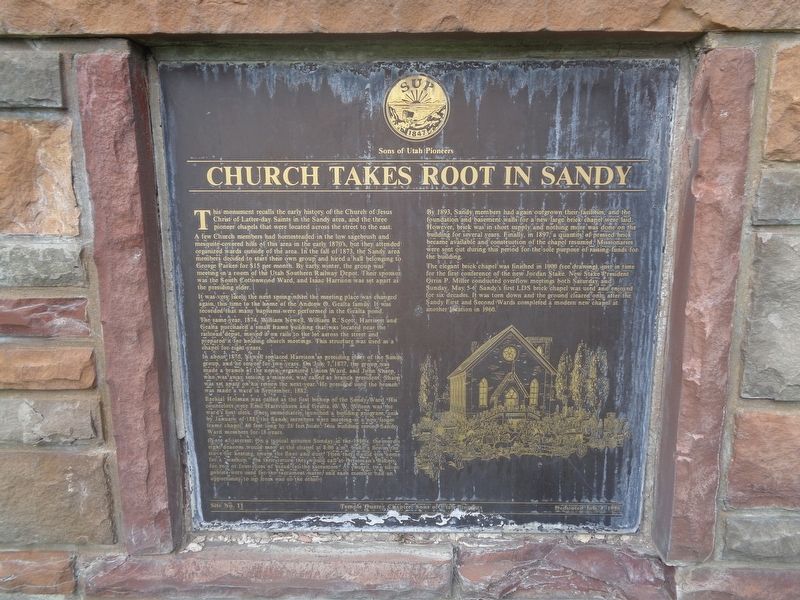Sandy in Salt Lake County, Utah — The American Mountains (Southwest)
Church Takes Root in Sandy / Early Sandy Schools
Church Takes Root in Sandy
This monument recalls the early history of the Church of Jesus Christ of Latter-day Saints in the Sandy area, and the three pioneer chapels that were located across the street to the east.
A few Church members had homesteaded in the low sagebrush and mesquite-covered hills of this area in the early 1870’s, but they attended organized wards outside of the area. In the fall of 1873, the Sandy area members decided to start their own group and hired a hall belonging to George Parker for $15 per month. By early winter, the group was meeting in a room of the Utah Southern Railway Depot. Their sponsor was the South Cottonwood Ward, and Isaac Harrison was set apart as the presiding elder.
It was very likely the next spring when the meeting place was changed again, this time to the home of the Andrew O. Gealta family. It was recorded that many baptisms were performed in the Gealta pond.
The same year, 1874, William Newell, William R. Scott, Harrison and Gealta purchased a small frame building that was located near the railroad depot, moved it on rails to the lot across the street and prepared it for holding church meetings. This structure was used as a chapel for eight years.
In about 1875, Newell replaced Harrison as presiding elder of the Sandy group, and he served for two years. On July 7, 1877, the group was made a branch of the newly-organized Union Ward, and John Sharp, who was away serving a mission, was called as branch president. Sharp was set apart on his return the next year. He presided until the branch was made a ward in September, 1882.
Ezekial Holman was called as the first bishop of the Sandy Ward. His counselors were Emil Hartvicksen and Gealta. W.W. Wilson was the ward’s first clerk. They immediately launched a building program, and by January of 1883 the Sandy members were meeting in a new larger frame chapel, 40 feet long by 26 feet wide. This building served Sandy Ward members for 18 years.
(Note of interest: On a typical autumn Sunday in the 1880’s, the ward’s eight deacons would meet at the chapel at 8:00 a.m., build a fire in the stove for heating, sweep the floor and dust. Then they would run home for a “washup.” On their return they would call at Osterman’s Bakery for two or four slices of bread for the sacrament. At church, two silver goblets were used for the sacrament water, and each member had an opportunity to sip from one or the other.)
By 1893, Sandy members had again outgrown their facilities, and the foundation and basement wall for a new large brick chapel were laid. However, brick was in short supply and nothing more was done on the building for several years.
Finally, in 1897, a quantity of pressed brick became available and construction of the chapel resumed. Missionaries were sent out during this period for the sole purpose of raising funds for the building.
The elegant brick chapel was finished in 1900 (see drawing), just in time for the first conference of the new Jordan Stake. New Stake President Orrin P. Miller conducted overflow meetings both Saturday and Sunday, May 5-6. Sandy’s first LDS brick chapel was used and enjoyed for six decades. It was torn down and the ground cleared only after the Sandy First and Second Wards completed a modern new chapel at another location in 1960.
Early Sandy Schools
Sandy’s first school building, a single room, was constructed on this property in 1881. However, the community’s first classes of learning were held somewhat earlier at an unknown location in a log cabin.
Dimensions of the first school, painted blue, were 25 by 45 feet. Furniture included a number of chairs and a few long benches. Seats were paired side by side in three rows. The teacher’s desk and a stove were also in the room.
During the colder months the children took turns bringing in wood and coal to keep the fire burning in the stove. Older boys brought fresh water daily from the old well in Sandy’s business area. At lunchtime each boy and girl drank from the single long-handled dipper. Forty students of all ages attended Sandy’s one-room school the first year.
Sadie Tripp was the first teacher. She taught alone for two years, then was joined by a Miss Gibson and Flora Tripp. Later, John Smith and William M Stewart became part of the faculty. The first principal was James B. Jensen. Stewart’s contributions in Sandy and elsewhere were recognized by Dr. John R. Park, first president of the University of Utah, where he named the university’s elementary training school for the young teacher.
Books used in Sandy’s first school were The Pacific National, Wilson’s Readers, Ray’s Arithmetic, Penny’s Grammar, and the famous McGuffey Readers. Students furnished their own books, pencils and slates. Boys in the class cleaned their slates by spitting on them and then wiping them with their shirtsleeves. The girls were more genteel – they brought small bottles of water and rags from home to do the job.
In the evenings the schoolhouse was used for debates, spelling bees and town meetings. As time passed the school was expanded to two rooms – then more.
In the early 1890’s a high-ceilinged, two-story, dull red brick school replaced the expanded frame structure. Its eight rooms – four on each floor – met the area’s needs for more than 15 years (see drawing).
Construction of a new three-story, 12-room school at the east of Main Street in 1907-08 marked the end of most, but not all, of the elementary education on this site. Some of the smaller classes still met here whenever the new school became overcrowded.
As the elementary students moved out, their older brothers and sisters moved in. Area education leaders decided in 1908 the vacated grade school should become the first permanent home of Jordan High School. Until then the area’s high school students had been meeting informally in Draper, West Jordan and East Jordan. Jordan High became the first high school in the south end of the Salt Lake Valley.
Enoch Jorgensen of Provo was the first principal. Teachers were Ross Anderson of Ephraim, and Mill A.W. Brown of Salt Lake City. E.C. Hart taught a branch class at Bingham. Ninety students registered for classes on opening day, September 9, 1908 – 63 freshman and 10 sophomores at Sandy, and 17 freshmen at Bingham.
Jordan High moved to its new building on State Street in 1913. Since then the old school has housed the Sandy City offices, the fire department, an athletic clubhouse, a wedding reception and dance hall, a library, and currently, in just a remnant of the building, the Senior Citizens’ center.
Erected 1986 by Sons of Utah Pioneers (Temple Quarry Chapter). (Marker Number 11.)
Topics and series. This historical marker is listed in these topic lists: Churches & Religion • Education. In addition, it is included in the Daughters of Utah Pioneers series list. A significant historical date for this entry is September 9, 1908.
Location. 40° 35.521′ N, 111° 52.94′ W. Marker is in Sandy, Utah, in Salt Lake County. Marker is on South 280 East north of East 8800 South, on the right when traveling south. Touch for map. Marker is at or near this postal address: 8768 S 280 E, Sandy UT 84070, United States of America. Touch for directions.
Other nearby markers. At least 8 other markers are within walking distance of this marker. Sandy Tithing Office (about 500 feet away, measured in a direct line); Amos and Ida Jensen House (about 600 feet away); Mary Ellen Parmley House (about 700 feet away); Sandy-Alta Railroad (approx. ¼ mile away); Niels & Mary Ann Thompson House (approx. ¼ mile away); John & Elizabeth Oldham House (approx. ¼ mile away); John & Johanna Anderson House (approx. ¼ mile away); John & Myrtle Ostler House (approx. 0.4 miles away). Touch for a list and map of all markers in Sandy.
Credits. This page was last revised on December 31, 2023. It was originally submitted on December 31, 2023, by Jason Voigt of Glen Carbon, Illinois. This page has been viewed 51 times since then and 35 times this year. Photos: 1, 2, 3. submitted on December 31, 2023, by Jason Voigt of Glen Carbon, Illinois.


